Outdoor fire water supply - features and purpose of this
This type of communications as an external fire water supply system is designed so that in case of need, a motor vehicle engaged in fire fighting can join the system and receive the required amount of water. Certain requirements are imposed on its characteristics and parameters, and we will consider them in this article.
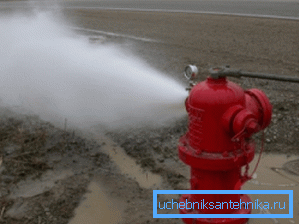
Conditions for ensuring the performance of communications
Due to the fact that the fire protection systems are laid in parallel with industrial and civil water supply networks (except for some cases, which we will discuss below), but are not serviced by the water utility, the control of their condition is entrusted to authorized employees.
The most important criterion to which special attention is paid is the readiness of the equipment for use at any time. In this regard, there are basic requirements for outdoor fire water supply:
| Accurate Accounting | There should be separate schemes, which indicate the exact location of all hydrants on the ground. This is very important, as in the case of emergency situations there is no time for thinking, and the information should be clear and accessible. Plans should be periodically checked for relevance, if necessary, they are corrected accordingly. |
| Periodic control | It is necessary to constantly check the condition of the equipment, and there are quite a lot of control criteria, and we will discuss them below. This factor is paid the closest attention, and responsible for its execution are senior management positions in the relevant regional offices of the MES |
| Preparatory activities | All systems need periodic maintenance, which is aimed at preparing for the conditions of use in the warm and cold season. The greater the average annual temperature drops, the greater the importance of preparatory activities. |
| Annual tests | In addition to regular inspections, at least once a year, an external fire-fighting water line should be tested for water loss. The methodology for this major event will be described in detail below. |
Tip! All necessary information on this issue can be obtained from the regional emergency management offices. They are obliged to hold a consultation and clarify all the questions you are interested in on request.
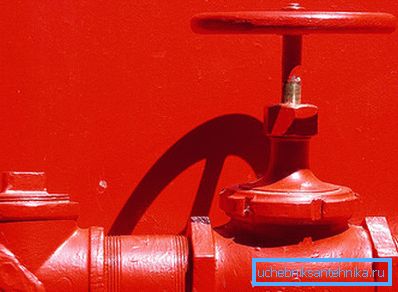
Fire Water Check
Due to the fact that most communications are laid underground, the condition of external elements is estimated, as well as some other factors:
- The presence of convenient access roads to the location of the feeding node. The width of the road should be at least 3 meters per vehicle unit, in addition, there should be a platform for turning cars. The quality of the road surface is also regulated: it should be firm and resistant to moisture, ideal options are asphalt or concrete, but other solutions are allowed if they provide the necessary strength.
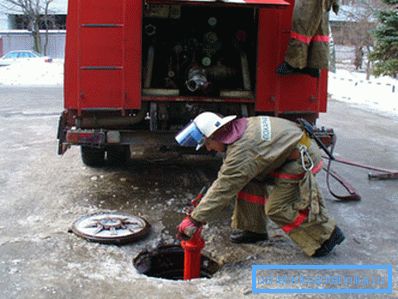
- The condition of the well in which the hydrant is located (if any)). It is very important that the walls are strong, without cracks and collapsing area. This test is usually carried out in the spring period of the year, when the groundwater is above all, and any problems are immediately visible.
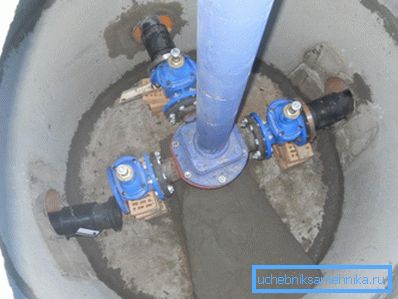
- The well in which the hydrant is located must be equipped with a cover, it must provide reliable protection. The lid is periodically cleaned of corrosion and dirt, and in the winter period of the year it is recommended to clean it of snow and ice and cover it with a box for warming and preventing the freezing of metal.
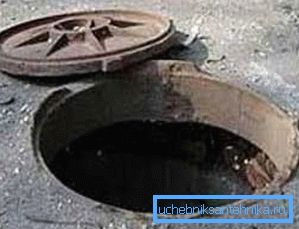
- There should be information signs indicating the location of water supply units for fire fighting needs.. From time to time they should be updated so that the information is read from afar.

- It is checked that all assemblies and valves are in good condition, this is a very important factor, since in conditions of temperature changes and high humidity the metal elements can be damaged by corrosion and rust to each other.. Therefore, some nodes are clogged with grease, and on the others the paintwork is periodically updated.
All these activities are carried out by external inspection and testing of the work of some units, it all depends on the specifics of an object and the general state of the system.
Some features of the device fire-fighting communications and methods of testing
According to SNiP 2.04.02-84 "Water Supply Outdoor Networks and Structures", the design and calculation of communications must comply with a number of rules and regulations. According to this regulatory act, the basic parameters of the systems are regulated, and we will consider them first.
Types of systems and their features
Fire communications are arranged in all localities, as well as in industrial areas and at the facilities of the national economy. Most often, they are laid in parallel with civil and industrial water pipelines and are located in the ground below the ground freezing point.
In the following cases, the use of special tanks and reservoirs:
- If the system is set up in settlements of no more than 5 thousand people, most of the villages and some small cities fit this category.
- If a separately constructed building with an area of up to 1 000 m2 does not have a circular fire line.
- To ensure fire safety of various storages, refrigeration units, transmission stations and other objects not related to the use of fire hazardous substances.
- Warehouses of mineral fertilizers up to 5,000 m2 can also be equipped with a special tank or reservoir on or near the territory.
- If the calculated consumption rate for fire extinguishing in an enterprise is 10 liters per second or less, then this option is also suitable.
- In some cases, this solution may also be used as the main option, but this requires coordination with state fire supervision authorities.
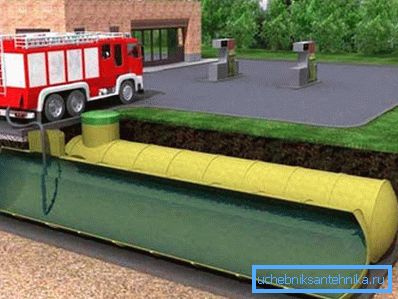
The flow of water required for fire extinguishing at a particular site is calculated based on how much liquid is needed for the largest building. Typically, this figure ranges from 10 to 35 liters per second.
If we are talking about industrial facilities, the calculation method is similar to that described above: the flow rate is determined by the largest facility located in the service area of the hydrant.
It is worth noting that the exact definition of certain parameters is made on the basis of special calculations, they are unlikely to be able to do it yourself, since only specially authorized bodies can carry out such activities. The price of such services is very high, but it is still unlikely to be abandoned.
There are cases when the device of fire-fighting communications is not required:
- In settlements, the number of inhabitants in which does not exceed 50 people.
- If buildings are built no higher than two floors.
- For separately located catering facilities with an area of no more than 150 m.
- For warehouses of no more than 50 m2.
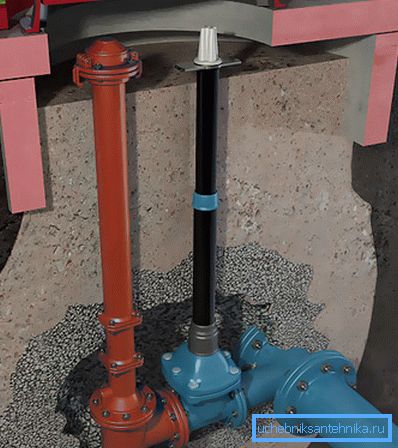
Test activities
The method of testing the outdoor fire water supply for water loss has a number of features, we will consider them in this chapter:
- The frequency of control - at least once a year. Work necessarily carried out in the spring.
- Inspection is mandatory performed on new facilities, put into operation after major repairs.
- The work is carried out by representatives of the water utility together with the local emergency management. On the results of the work carried out in a mandatory manner an act of the established form.

There are a number of sites that should be tested in the first place, as in these places according to statistics, problems and failures most often arise:
- Long lines - as a rule, the greater the distance of the pipeline, the higher the probability of pressure loss in the system.
- Lines that are farthest from pumping nodes. It is much more difficult to maintain pressure in such systems, and any leaks and malfunctions lead to a significant drop in pressure.
- Highways with significant water consumption indicators also need special attention. This is due to the fact that the use of fluid in pipes during peak periods of time can cause a catastrophic pressure drop in the system, which is unacceptable.
- All territories in which explosive objects are located are located fire-hazardous production and other unsafe buildings, it is necessary to check with special care, since in case of emergency situations the danger of these places increases tenfold.
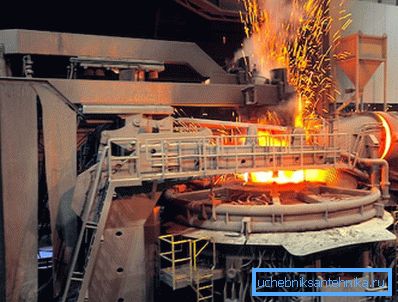
- Dead-end branches and old lines are another type of structure, in which the probability of malfunctions is much higher than in standard systems. Therefore, they are checked first.
- If, due to the nature of operation in the pipeline, low pressure is maintained, then this part of the system also applies to objects that need to be checked first.
- The last group of structures is pipelines with a small diameter (up to 100 mm). In view of the small diameters, in order to maintain the necessary working capacity, it is necessary to constantly maintain high pressure in the system.
The test method for external fire water supply for water loss is as follows:
- Determine what indicators of pressure and water flow should be in the network so that it meets the standards set forth in the regulatory documentation.

- Measure the actual water flow per unit of time.
- Determine the actual head in the system.
- Compare the design figures with the actual ones and draw up a conclusion on the conformity or non-compliance of the system parameters; all possible deviations are determined by the instruction set forth in the SNiP.
On the basis of the audit, a plan is drawn up to provide water to the lines in case of a fire, of course, if everything is normal, then this item can be omitted.
Important note! Check the flow and pressure of water should be made at the time of peak water consumption. In the residential sector this time from 7 to 9 am, at industrial facilities - a lunch break.
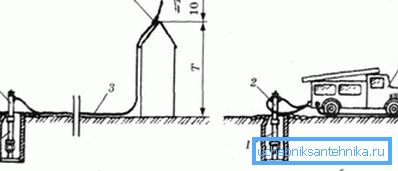
Conclusion
Fire-fighting communications belong to the group of objects that are not needed in everyday life, but are very important in the event of an emergency. It is required to maintain all such lines in working condition. The video in this article will explain some important questions in more detail.